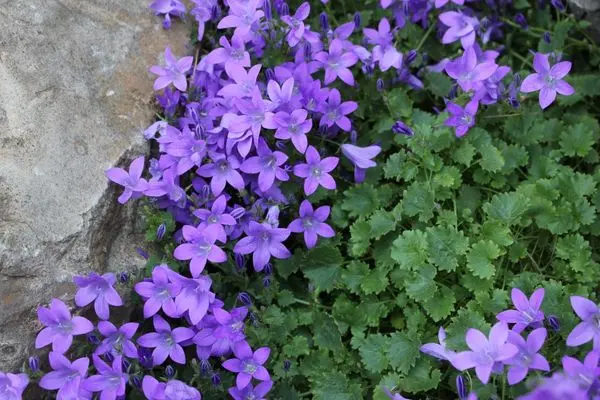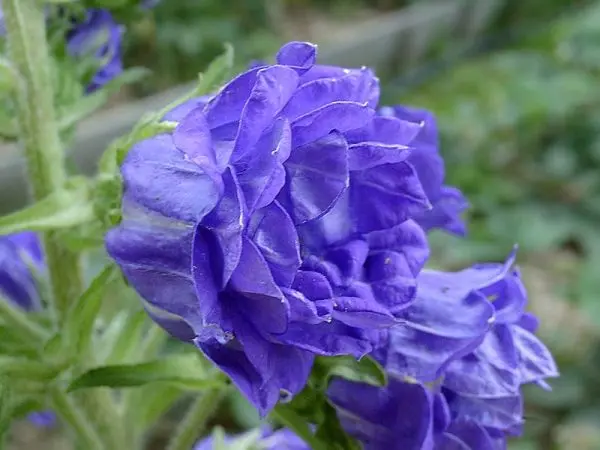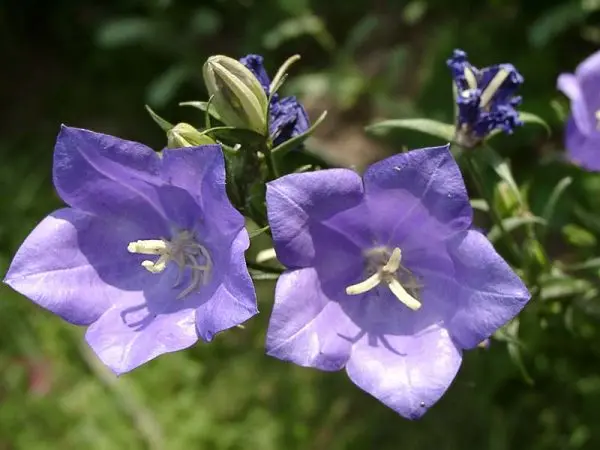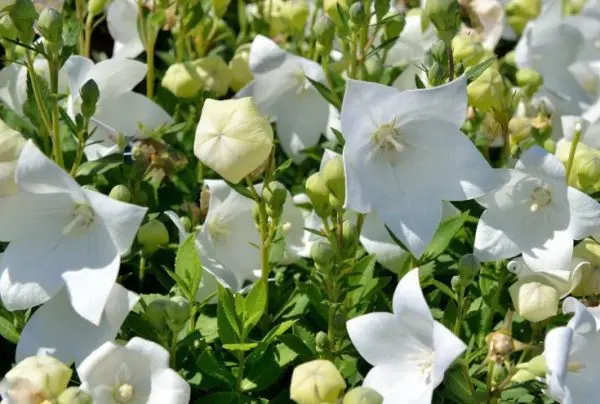It is rare to find a courtyard where gentle bells would not nod, agreeing with the wind. Single bluebells in the meadow look surprisingly meek and somewhat sad, and the bushes look like cheerful families. In the yards, we usually grow them in groups, we settle bright ones with large flowers, collected in a panicle or single, so that they adorn our yards all summer.
Description
Bellflower is a herbaceous plant of the Bellflower family. The genus includes more than 300 species, less than 100 of them are cultivated. In the wild, it grows in Europe and Siberia, Asia and the Caucasus. It is found in fields, meadows, forests, mountains, even on desert rocks.
Perennial plant with alternate leaves and a bell-shaped flower of white, blue, purple or lilac flowers in different shades. Inflorescences are most often paniculate, rarely racemose, sometimes solitary. There are annual and biennial, but summer residents like to grow perennial bells that can decorate yards from 3 to 10 years. Their seeds ripen in boxes with 4 or 6 special slots, which are closed in wet weather, but open in dry weather so that the ripened seeds are carried by the wind.
 Sorts
Sorts
With a wide variety of species, up to 10 known perennials of this genus remain the most popular. All species are conditionally divided into 2 groups: tall ones that grow freely in meadows, fields and forest clearings, and stunted ones that huddle on rocks. Tall form bushes over 40 cm tall.
The nettle bell grows up to 100 cm, forms many straight stems covered with rough serrated leaves. It blooms for 15 – 20 days with blue-violet flowers, collected in a long (up to 45 cm) brush. Prefers partial shade, fertile soils and regular watering. After the flowers wither, the shoots dry out, if they are not cut off, the seeds are quickly sown.
The milky-flowered bell grows even higher, from 80 to 120 cm, blooms with white, lilac, purple flowers, collected in wide pyramidal inflorescences. Each inflorescence has up to 100 flowers with a delicate aroma. The most popular variety is Loddon Anna.
The peach-leaved bell grows on sandy soil up to 100 cm high. The wedge-shaped basal leaves are collected in a rosette, lanceolate ones grow on the stems. Large (up to 5 cm long) white, blue, lilac flowers are collected in paniculate inflorescences of 5-6 pieces. It blooms for 40 days, starting from the second half of July. Every 2 – 3 years you need to replant the plant and divide the bush (or thin out). Popular varieties: Celestina, Mertvima, Marginata.

A crowded bell grows up to 60 cm tall, oblong jagged leaves at the root – on long cuttings, and at the top of the stem – without cuttings at all. Large white, blue, purple flowers reach 2 cm in diameter, collected 20 pieces in capitate inflorescences, bloom up to 35 days in the middle of summer. They love sunny lawns, but grow well in partial shade, the bush grows very quickly. Known varieties: “Alba”, “Superba”, “Captivity”.
Of the undersized species, the Carpathian is especially famous: it grows up to 30 cm, white, blue, purple single flowers up to 5 cm in diameter look like a wide bell. Blooms for more than 2 months, starting in June. It grows on loose loam, loves sunlight, almost does not need watering. Propagated by sowing, blooms no earlier than the third year. Popular varieties: “White Pearl”, “Samantha”, “Blaue Clips”.
Pozharsky’s bell spreads along the ground, rising to a height of 20 cm. Its flowers look like stars, lilac, pink, blue in different shades, they gather in small inflorescences. Likes partial shade, blooms up to 40 days in the middle of summer.
The Portenschlag bell (we grow the Birch Hybrid variety) grows no higher than 15 cm. It grows into a lush evergreen cushion with purple or reddish star-shaped flowers. Grows in sun or shade on light, nutrient-rich soils.

Video “Garden bell”
Video recommendations for growing a garden bell in flower beds, plant care, its fertilizer and top dressing.
Cultivation
Almost all types of perennial bluebells propagate using cuttings, dividing a bush or rhizome. The exceptions are species in which the taproot is not divided, they reproduce only with the help of seeds. You can sow in spring or autumn directly into the ground, or you can grow seedlings and plant strong plants in phase 3 of true leaves in garden beds with the onset of heat.
With vegetative propagation, the bush can be divided in the third year of the plant’s life, and some varieties even earlier. It is necessary to root a divided bush or parts of the root in the fall before the onset of cold weather, that is, it is better to plant in August or May. Root suckers or parts of the rhizome with buds should be planted so that the renewal bud is above the ground.
Вyou need to grow bells in a sunny clearing, where groundwater does not come close to the surface. They will be satisfied with light nutritious soil, sandy or loamy, neutral, even slightly alkaline. If the soil is dense, you need to add sand and humus, if slightly acidified, it is better to add wood ash. It is better to prepare the place in advance – dig it up well, add superphosphate and rotted manure. These flowers do not like peat or fresh manure, they can get fungal infections.

Flower care involves moderate watering (it is better to dry than pour), top dressing, weeding and loosening the earth around the roots. In the spring, nitrogen fertilizers are applied, then you can mulch with compost or rotted manure. Before flowering, it is recommended to apply mineral fertilizers of low concentration.
To prolong flowering, you need to remove faded flower stalks in time. It is advisable to remove weeds in a timely manner, loosen the soil to ensure oxygen access. This is such an unpretentious plant that it pleases summer residents who appear in the garden only for the weekend – you can not fertilize it, not water it (the main thing is to weed and loosen it sometimes), it will still bloom beautifully.
The worst thing for a bell is waterlogged earth and stagnant water, this can lead to the appearance of slugs, fungi, and winter freezing. This is the case when it is better not to pay too much attention, because in the wild they live perfectly even on bare stones. Seed boxes (if seeds are needed) must be picked and dried separately from the plant so that they do not have time to get enough sleep by self-sowing.
landscape use
Perennial bluebells are often used in mixborders, tall species look great in mixed background beds. No matter how long they bloom, then a not very beautiful plant remains, so it is better to remove it from the foreground. They look best when planted in small groups of the same color.
Undersized species are planted in rockeries, they look spectacular next to the stones. Very beautiful decorative borders are created from various undersized species. Most varieties take root well in shaded garden plots, so they are planted in shady flower beds. Cut flowers are well preserved for 10 – 15 days, they are often used in the preparation of bouquets.

Video “Carpathian bell”
From this video you will learn how to plant a perennial bell for seedlings.









